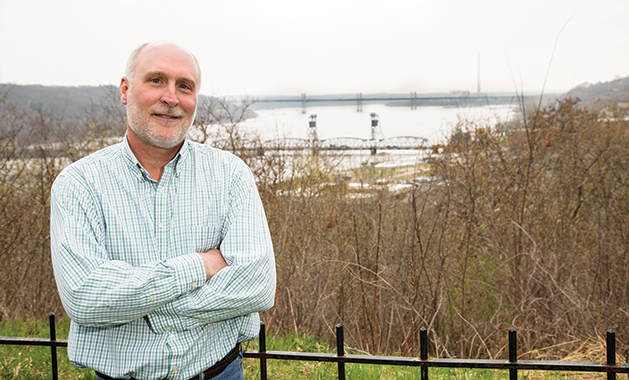
Forty different species of mussel stud the St. Croix River bottom. Among them, the hazel-shelled Higgins-eye mussels distribute their eggs on the gills of passing fish. Factors such as pollution and invasive animals have placed these mollusks on the endangered list.
Also endangering: a new bridge crossing the river between St. Joseph, Wis., and Oak Park Heights, Minn. Its five piers, or towers, would have marched straight through a Higgins-eye cropping if not for underwater surveyors from the Minnesota Department of Natural Resources. In preparation for construction, they spotted the threatened invertebrates and relocated them along the river so building could begin in 2013. Now the bridge, after a history of starts and stops, is set to open this August—provided the weather is dry enough, that is.
All things considered, a rain check wouldn’t be such a big deal for the project. Until a few years ago, challenges to construction entangled project managers in lengthy politics more often than the simpler-to-handle vagaries of weather. Relocating mussels made just one bullet point in an extensive list of mitigations the departments of transportation in Minnesota and Wisconsin had to check off before they could touch the federally protected St. Croix National Scenic Riverway. Court action involving the National Park Service pressed elected officials and even President Obama to intervene.
Contractors will finish construction only after due diligence from a 28-member team of stakeholders worked to reduce impact—on natural resources, as well as on social and aesthetic resources, such as nearby businesses and bluffs.
The new bridge, called St. Croix Crossing, will at last replace the Stillwater Lift Bridge located farther north. Traffic between states will soon find its way south of the Lift Bridge, which will become a historic byway for bikers and pedestrians.
For proponents of the bridge, the project has been a long time coming. St. Croix Crossing addresses complaints dating back to the 1960s—complaints about congestion caused by the Lift Bridge’s intermittent rising to let boats pass, as well as about safety concerns, especially congestion-related traffic accidents. Built in the early 1930s, it wasn’t designed for rush hour. Every day, around 18,000 cars and trucks cross the two-lane connection between tourist hotspot Stillwater and Houlton, Wis.
Additional roads will loop around to link the new bridge with Houlton and Stillwater. State highways 95 on the Minnesota side and 35 on the Wisconsin side will branch into it. Meanwhile, the outmoded Xcel barge unloading facility and the Terra Terminal building have been scrapped to preserve the area’s natural look. Here’s a look at how the project finally got underway and what it means for travelers and locals.
Getting Off the Ground, Keeping the Ground Out
The Minnesota Department of Transportation (MnDOT) first tackled the Lift Bridge problem in the mid-1980s. Not surprisingly, it focused on transportation.
“[At the time] The project wasn’t fully considering the amazing natural and historic resources of the area, a place that people from around the country come to visit,” says Todd Clarkowski, St. Croix Crossing project coordinator for MnDOT. Legal opposition to the project’s narrow focus forestalled federal approval well into the mid-’90s.
In the early 2000s, the Federal Highway Administration enlisted the U.S. Institute of Environmental Conflict Resolution to (of course) resolve the legislative bypass. That involved identifying 28 organizations that had a stake in whatever happened—from the Sierra Club to the St. Croix River Association to the Stillwater Lift Bridge Association to the Minnesota Center for Environment Advocacy. Together with the departments of transportation in both states, this group of stakeholders met every month for the next four years to discuss alternatives to the Lift Bridge—including the option of simply doing nothing.
The dual problem of congestion and safety again came to the forefront and demanded action. But a new bridge had to respect four qualities of what Clarkowski calls the “riverway perspective”: scenery, recreation, geography and water quality.
Regarding scenery, St. Croix Crossing’s communications manager Kristin Calliguri describes the bridge model unique to the Upper Midwest. Called an extradosed bridge, it’s the first of its kind in Minnesota and just the fourth in the United States. “We had to be really conscious of not disrupting the view,” Calliguri says. The bridge couldn’t stick out (at least, no more than any structure there automatically does). Two previously considered traditional options would have.
A box girder, like the 35W bridge, stands fairly low to the ground, but would need six piers in the water, affecting both recreation and, potentially, water quality. A cable-stayed bridge, like the Martin Olav Sabo Bridge, requires fewer piers but can stand at an obtrusive 100 feet tall. The St. Croix Bridge is 110–150 feet tall at the driving surface, with towers adding 65 feet.
An extradosed combines the benefits of each. It’s shorter than a cable-stayed bridge, with one fewer piers than a box girder. It’s also beige, emphasizing the surrounding bluffs, “so as you’re entering Wisconsin, it’s almost like you’re driving right into the trees,” Calliguri says.
Those bluffs caused problems of their own—particularly for water quality.
If construction disturbed the bluffs’ highly erodible soil, that soil would crumble down into the river. “Obviously, that’s bad for the aquatic life,” the Wisconsin Department of Transportation (WisDOT) project supervisor Tim Mason says, bringing up the mussels. Phosphorous from plants reduces dissolved oxygen in the water, triggering algae blooms.
To keep bluff vegetation rooted and the river clean, contractors rolled a layer of plastic over the ground while building the pier abutting the Wisconsin border. Infiltration ponds, meanwhile, take care of bridge runoff. Pitting both sides of the river, the ponds collect sediment, sand and gravel washed off the bridge during storms, thanks to a drainage system—again, with the safety of aquatic life in mind.
Although St. Croix Crossing ran into trouble when the National Park Service re-evaluated the project in 2010 and rescinded its approval, elected officials in Minnesota and Wisconsin assembled a coalition that pushed legislation all the way up to President Obama. Public Law 112-100 authorized St. Croix Crossing in 2012, as long as it met the standards set out in its mitigation package.
Local Businesses: Boom or Bust?
Craig Lund owns Big Guy’s BBQ Roadhouse off of Highway 35 in North Hudson. It opened in 2015, near where the new bridge will cross into Wisconsin. Lund is about to see a lot more traffic. “Part of the reason we picked the location is knowing the bridge is coming in,” he says.
The stakeholders’ mitigation package touches on accelerated economic growth in the region. Growth might sound unequivocally good, but stakeholders worked with authorities in western Wisconsin to develop land-use strategies and dole out extra funding to St. Croix County and St. Joseph in anticipation of greater population densities.
Stillwater, meanwhile, might at first glance appear to have lost business with the Lift Bridge’s closing to commuter traffic. But analysis by the Stillwater Chamber of Commerce found that congestion and safety concerns actually kept people from visiting.
“From my understanding, Stillwater is looking forward to commuters not having to sit in traffic and sit through all those lifts,” Calliguri says.
Commuters to Andersen Windows just south of the bridge in Bayport, Minn., for example, will have a quicker route from Wisconsin, freeing up streets around Stillwater for tourists. Rather than a conduit, after all, Stillwater works best as
a destination.
“People want to go there—they’re not just happening to be driving through,” Clarkowski says. Whereas potential visitors once might have opted out of an unpredictable drive, depending on rush hour and whether the bridge was up, less congestion means they can reasonably get downtown for lunch or out to Big Boy’s BBQ, taking the first exit off of the new bridge.
The Chamber of Commerce found business in Stillwater actually increased after flooding in 2014 forced the Lift Bridge to close. Traffic had settled; people came in to shop.
“That’s what we envision as a positive impact on the downtown Stillwater area,” Clarkowski says.
The old Lift Bridge, meanwhile, will carry bikers—plus a new paint job.
“When it rains out here, the lift bridge has holes, so rain water picks up chemicals off the bridge,” Clarkowski explains. The Lift Bridge, too, will use a drainage system in this case. Any water trickling back into the St. Croix will percolate through infiltration ponds.
The mussels will hardly notice.









